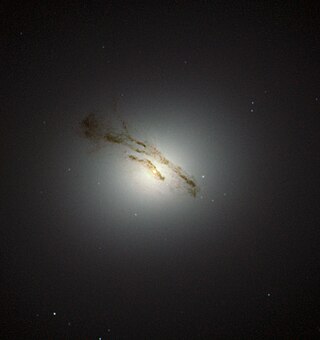Top Qs
Timeline
Chat
Perspective
Messier 84
Galaxy in the constellation Virgo From Wikipedia, the free encyclopedia
Remove ads
Messier 84 or M84, also known as NGC 4374, is a giant elliptical or lenticular galaxy in the constellation Virgo. Charles Messier discovered the object in 1781[a] in a systematic search for "nebulous objects" in the night sky.[7] It is the 84th object in the Messier Catalogue and in the heavily populated core of the Virgo Cluster of galaxies, part of the local supercluster.[8]
This galaxy has morphological classification E1, denoting it has flattening of about 10%. The extinction-corrected total luminosity in the visual band is about 7.64×1010 L☉. The central mass-to-light ratio is 6.5, which, to a limit, steadily increases away from the core. The visible galaxy is surrounded by a massive dark matter halo.[5]
Radio observations and Hubble Space Telescope images of M84 have revealed two jets of matter shooting out from its center as well as a disk of rapidly rotating gas and stars indicating the presence of a 1.5 ×109 M☉[9] supermassive black hole. It also has a few young stars and star clusters, indicating star formation at a very low rate.[10] The number of globular clusters is 1,775±150, which is much lower than expected for an elliptical galaxy.[11]
Viewed from Earth its half-light radius, relative angular size of its 50% peak of lit zone of the sky, is 72.5″, thus just over an arcminute.
Remove ads
Supernovae
Three supernovae have been observed in M84:
- SN 1957B (Type Ia, mag. 12.5) was discovered by Howard S. Gates on 28 April 1957, and independently by Dr. Giuliano Romano on 18 May 1957.[12][13][14]
- SN 1980I (Type Ia, mag. 14) was discovered by M. Rosker on 13 June 1980.[15][16] Historically, this supernova has been catalogued as belonging to M84, but it may have been in either neighboring galaxy NGC 4387 or M86.[17]
- SN 1991bg (Type Ia-pec, mag. 14) was discovered by Reiki Kushida on 3 December 1991.[18][19] This supernova has been studied extensively as a peculiar and underluminous Type Ia, and is now used as a template, with similar events being classified as Type Ia-91bg-like.[20]
This high rate of supernovae is rare for elliptical galaxies, which may indicate there is a population of stars of intermediate age in M84.[11]

Remove ads
See also
References and footnotes
External links
Wikiwand - on
Seamless Wikipedia browsing. On steroids.
Remove ads

